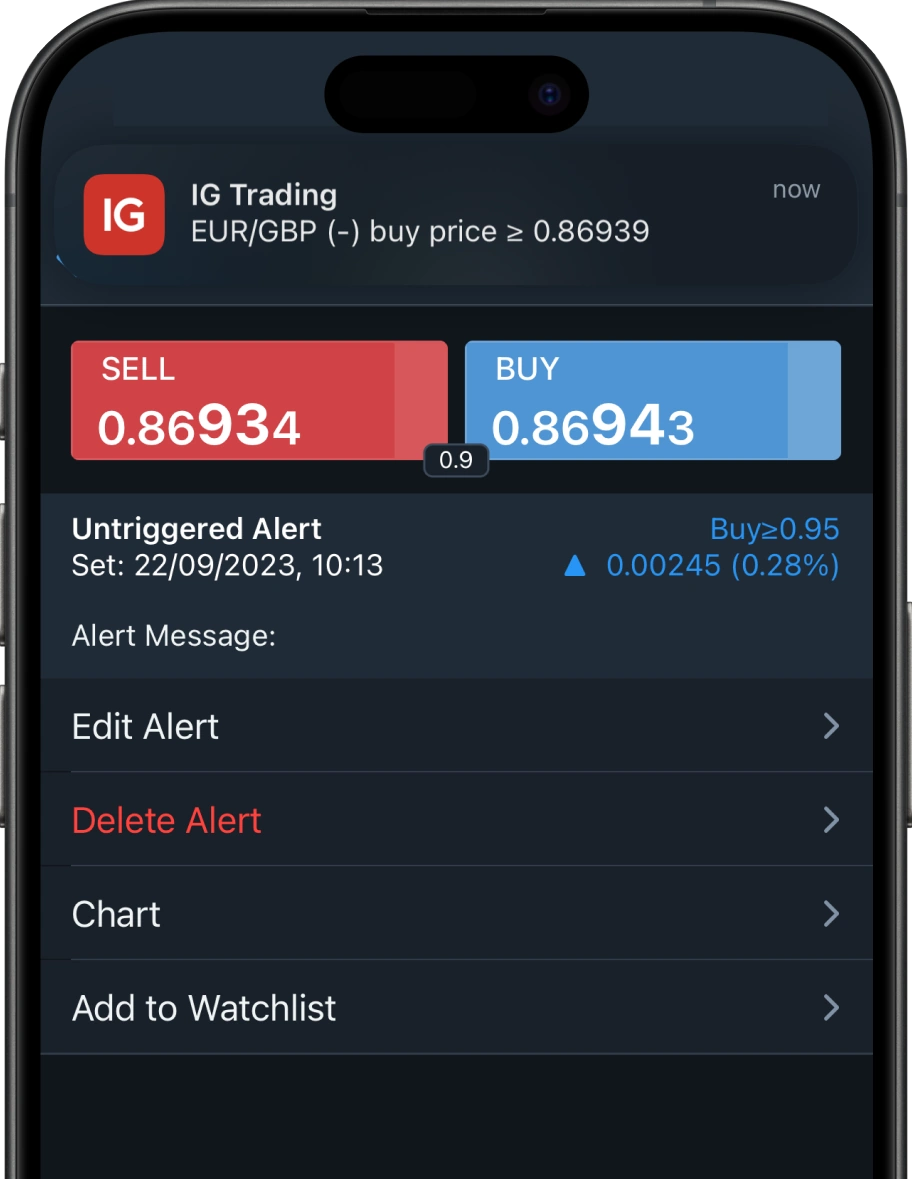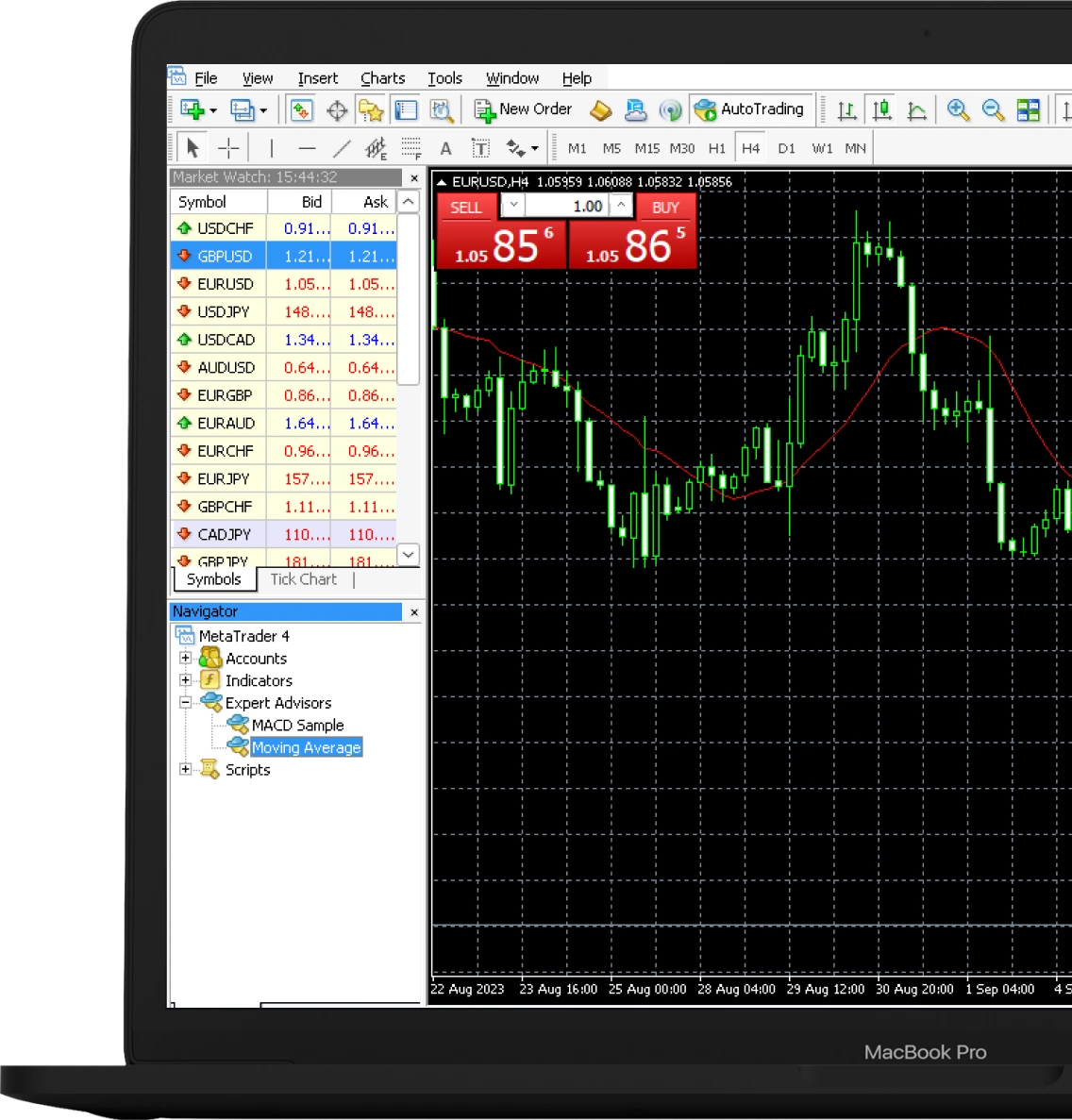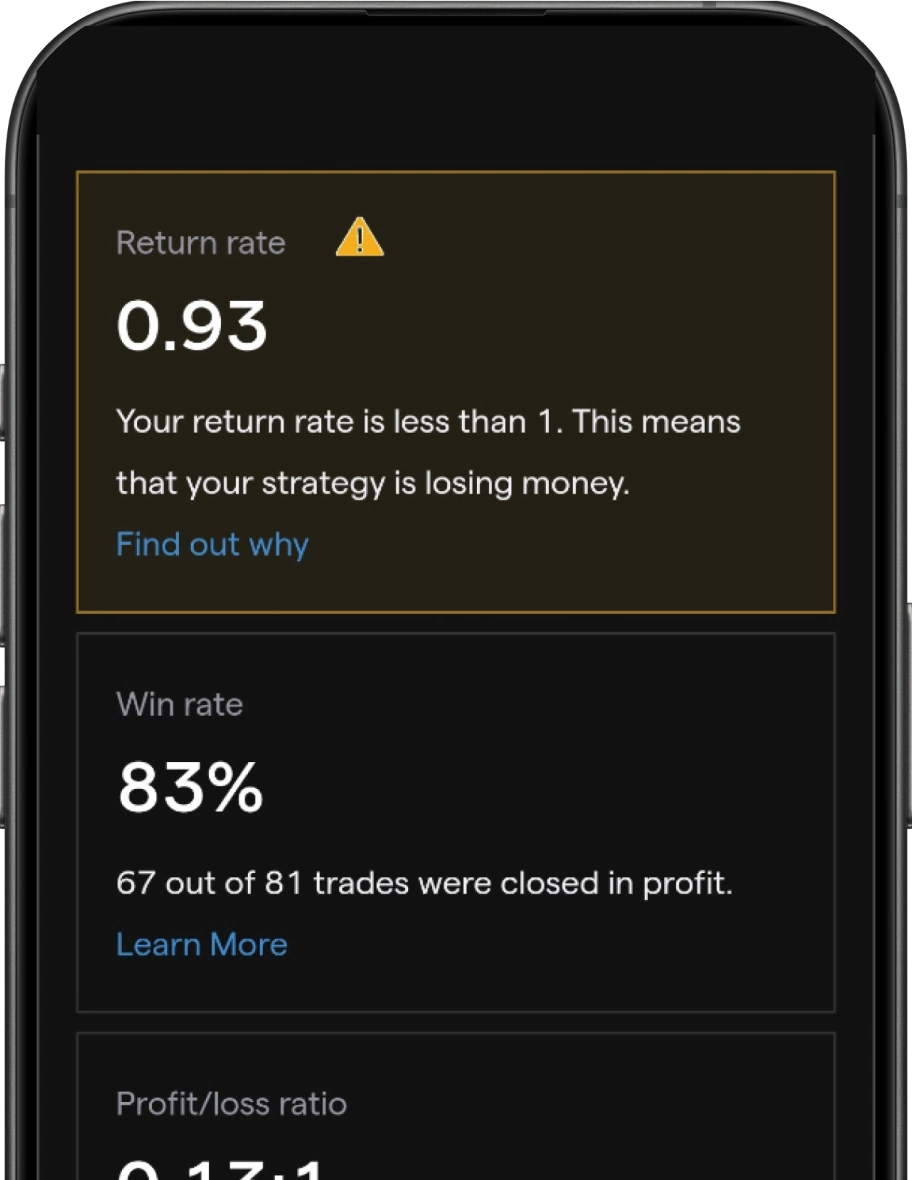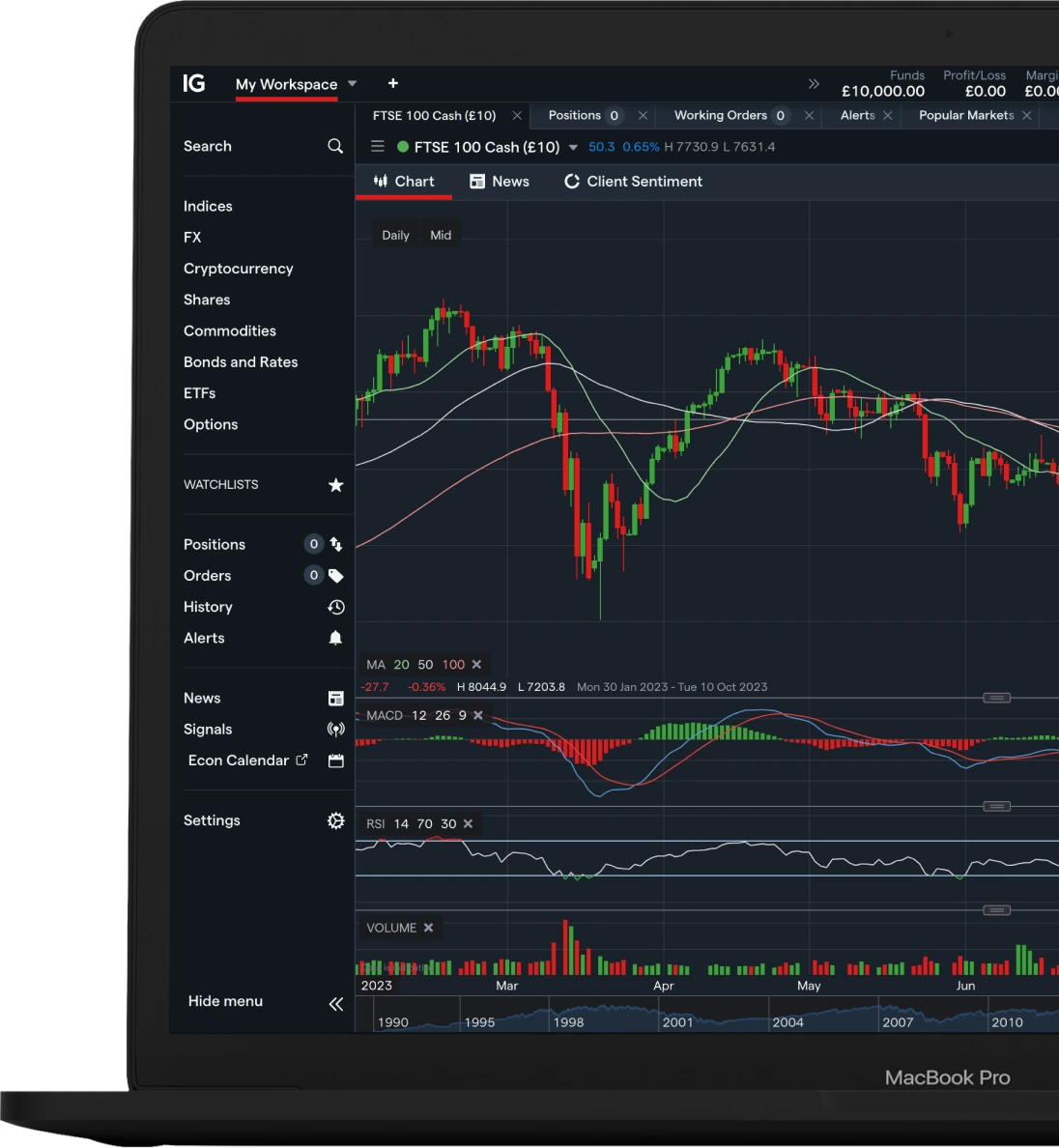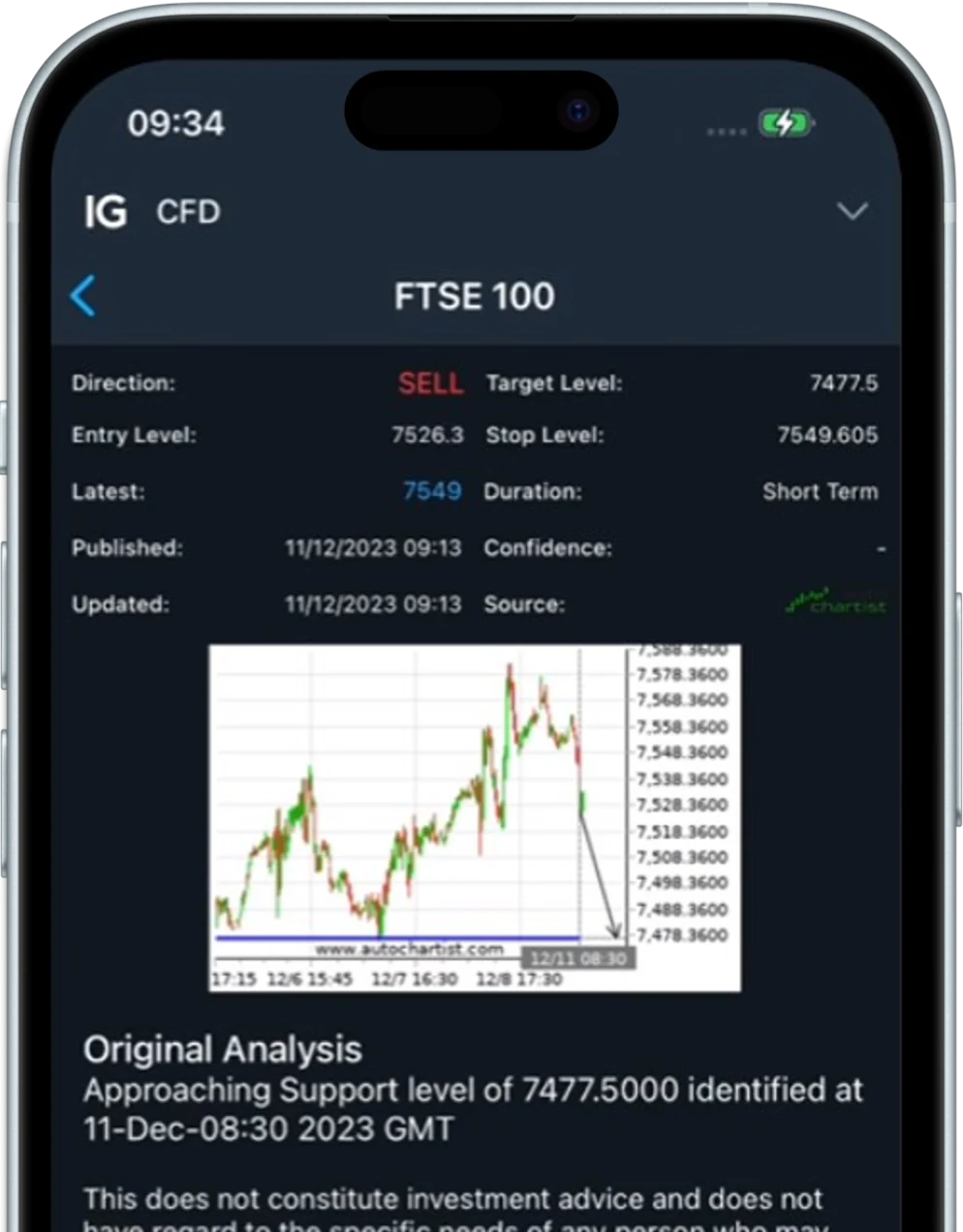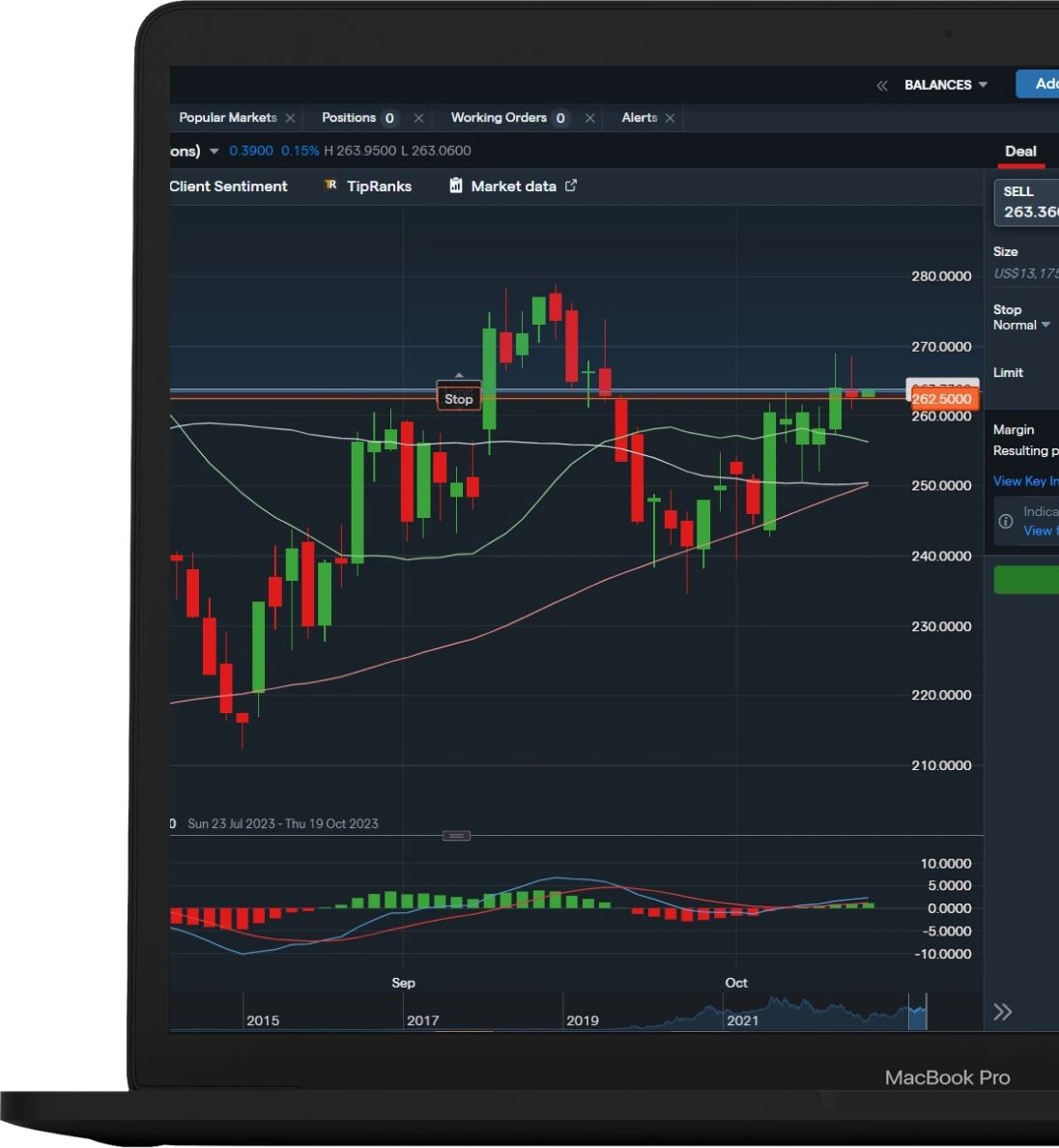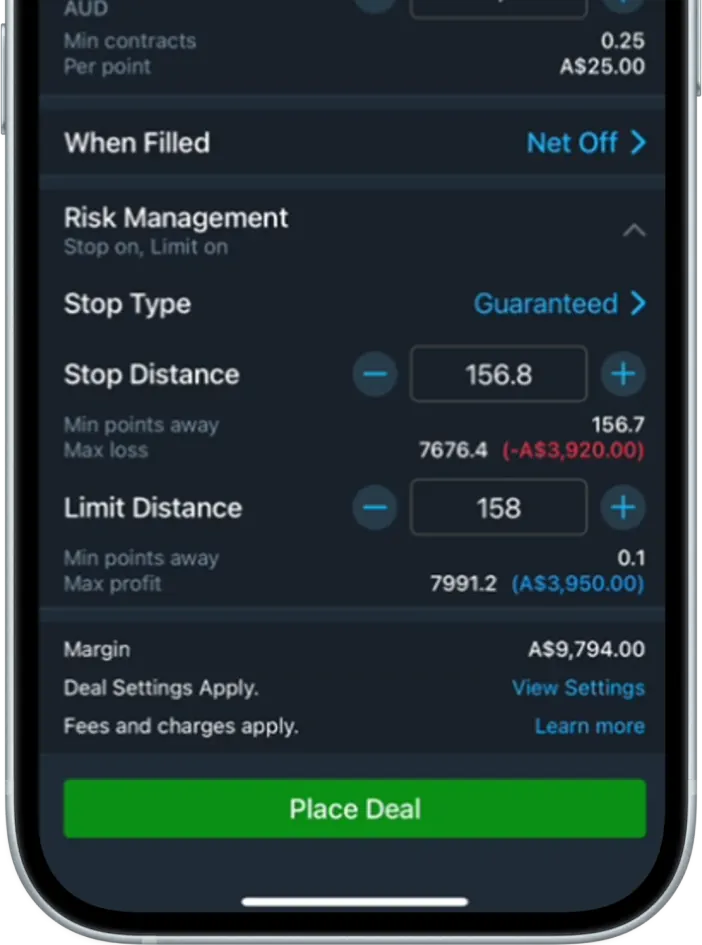Trade indices with IG
Turn ambition into reality with Australia’s No.1 CFD provider 1
- 36 indices incl. Australia 200, FTSE 100, Wall Street, etc.
- Trade 24/7 on our exclusive weekend indices markets 2
- Direct access to indices analysis from experts
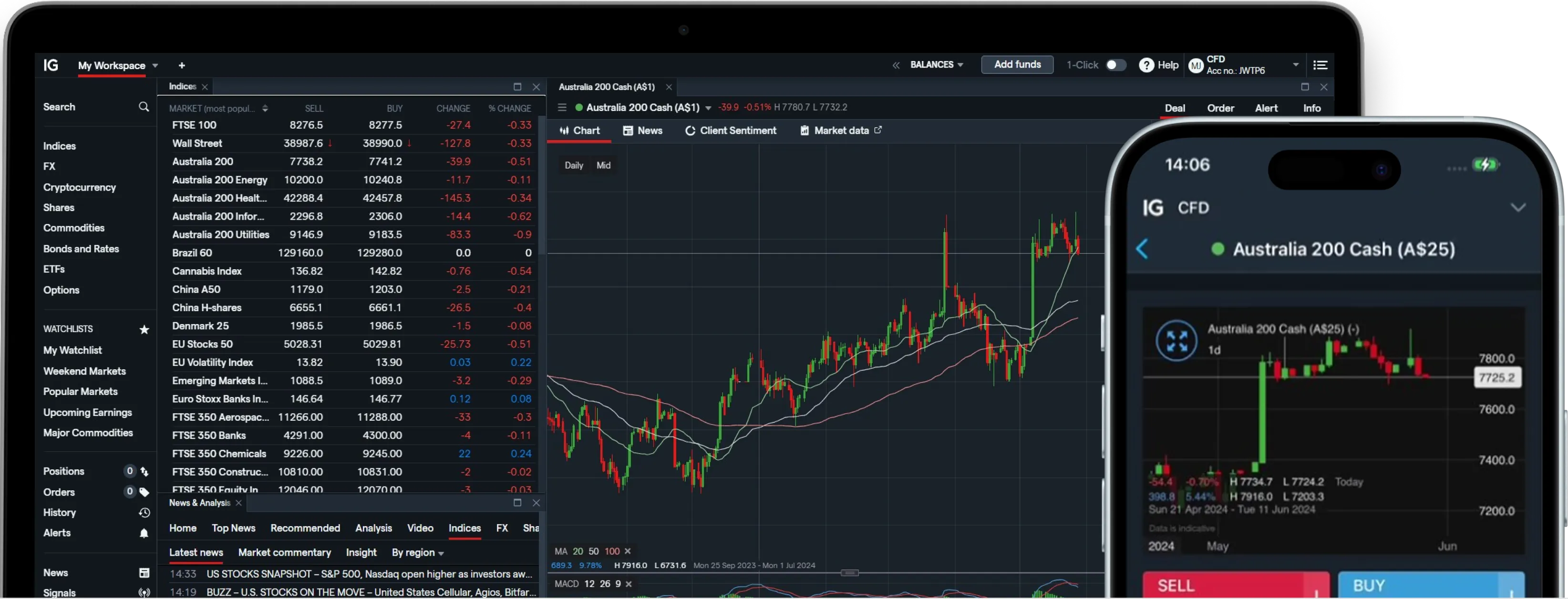
More than a trading platform
We support you at every stage of your journey
IG Academy
Access education for any and all experience levels. Free online courses, webinars, seminars, and video tutorials.
Round-the-clock support
Available 24 hours a day Monday to Sunday, except from 7am to 5pm Saturdays (AEST).
Easy-to-use app
Our trading platforms and mobile app are designed to be user-friendly and straightforward.
Access 36 indices markets
Gain the ability to trade on over 36 indices market; get spreads from 1 point on the Australia 200 and FTSE 100.
Exclusive trading hours and pricing
Exclusive 24/7 pricing on Wall Street, US Tech 100, FTSE100, HS50 and Germany 40 through weekend trading. 3
Latest news and expert analysis
Stay informed with the latest critical news and expert analysis i Get news and commentary from market experts and senior financial analysts, directly on our platform. to heighten market awareness.
Here’s what our clients say
Proudly award-winning
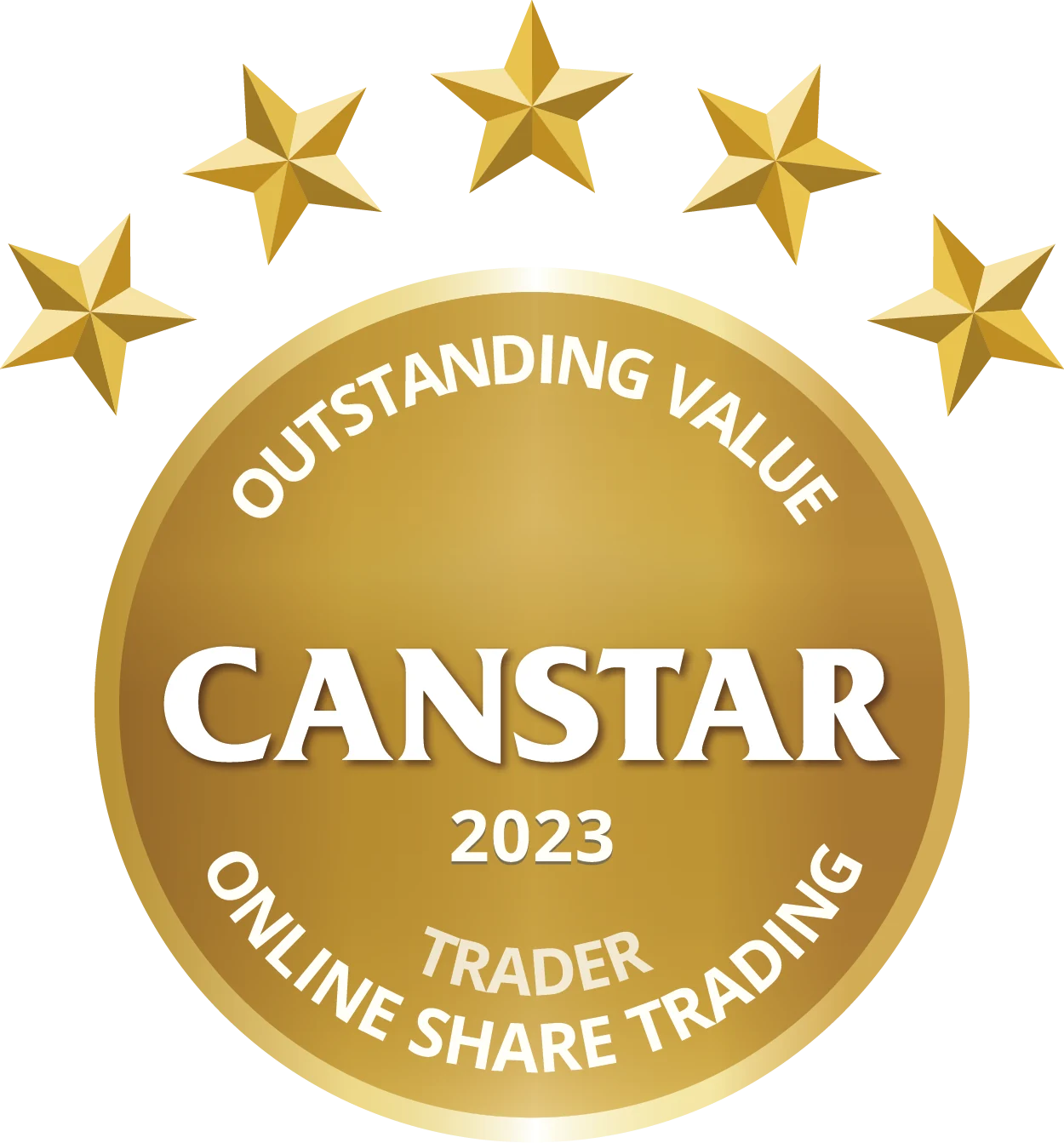
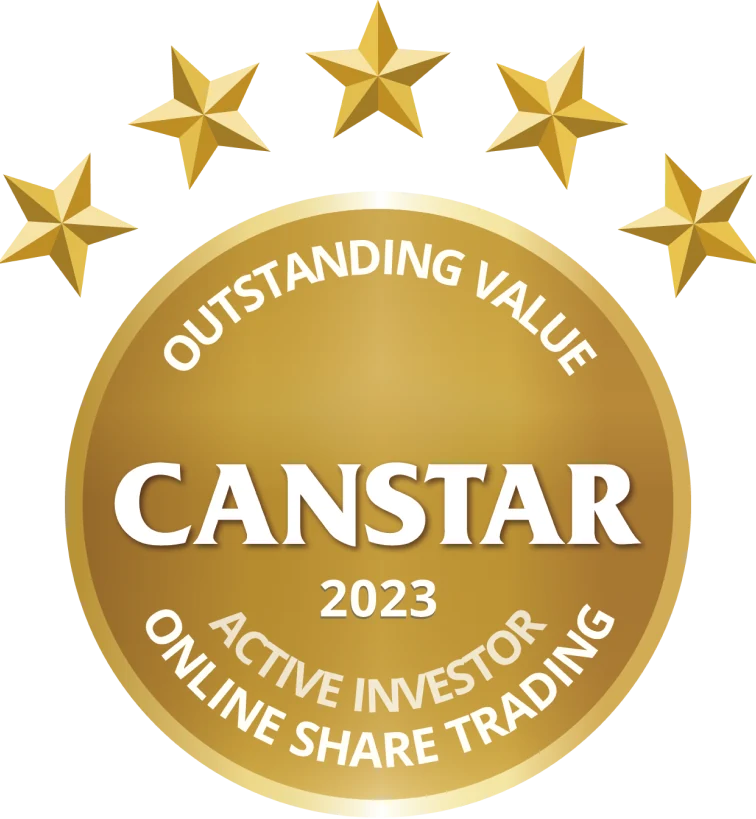
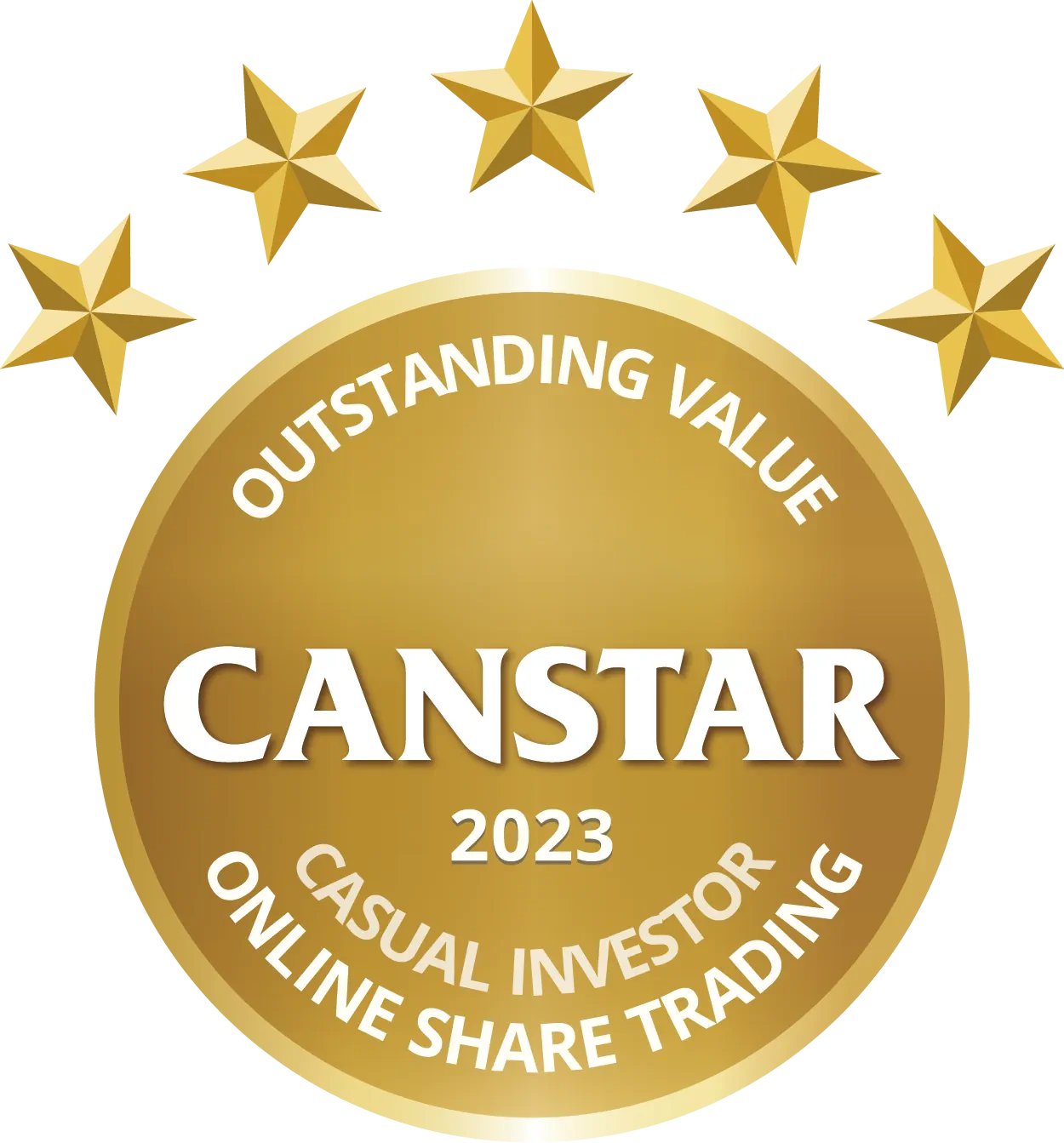
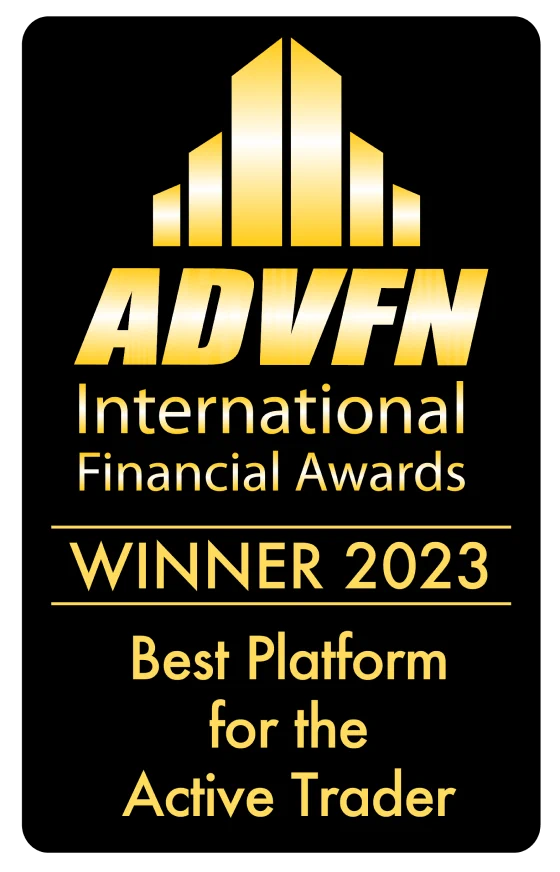
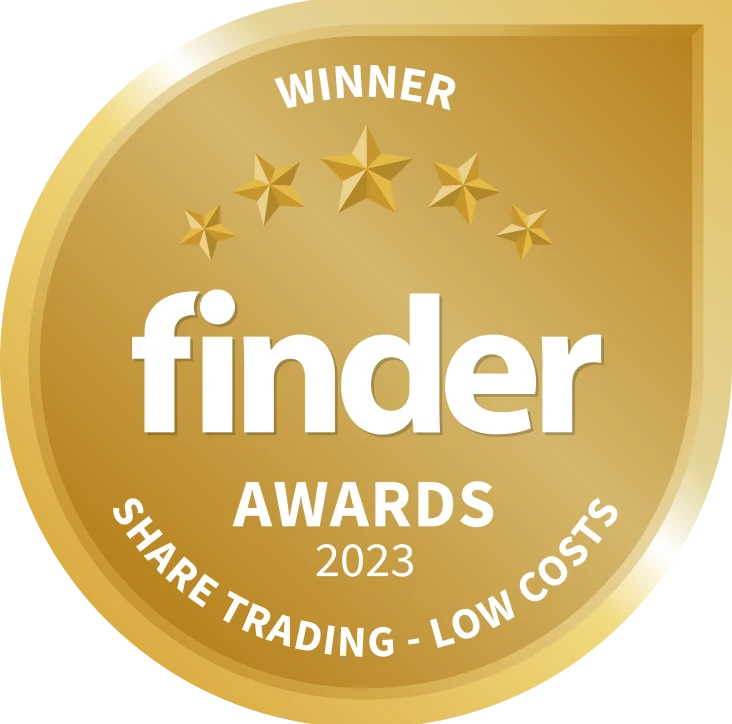

Join IG
It takes just 3 simple steps
A few questions
Let us know a bit more about you
Get verified
We can usually verify your identity immediately
Fund and start trading
We accept all major credit cards, PayPal, Apple Pay, BPAY
Trade seamlessly
On our user-friendly and award-winning platforms 4
All the features you need, whenever and wherever you need them.
Learn moreOur comprehensive online platform keeps you in control with alerts, signals, and trading analytics supplementing your strategy.
Learn moreUsing ProRealTime, MetaTrader 4 (MT4) or L2 Dealer? Looking for advanced charting or automated trading i Automated trading is the use of algorithms for making trade orders. ? Trade with IG and enjoy exclusive add-ons.
Learn more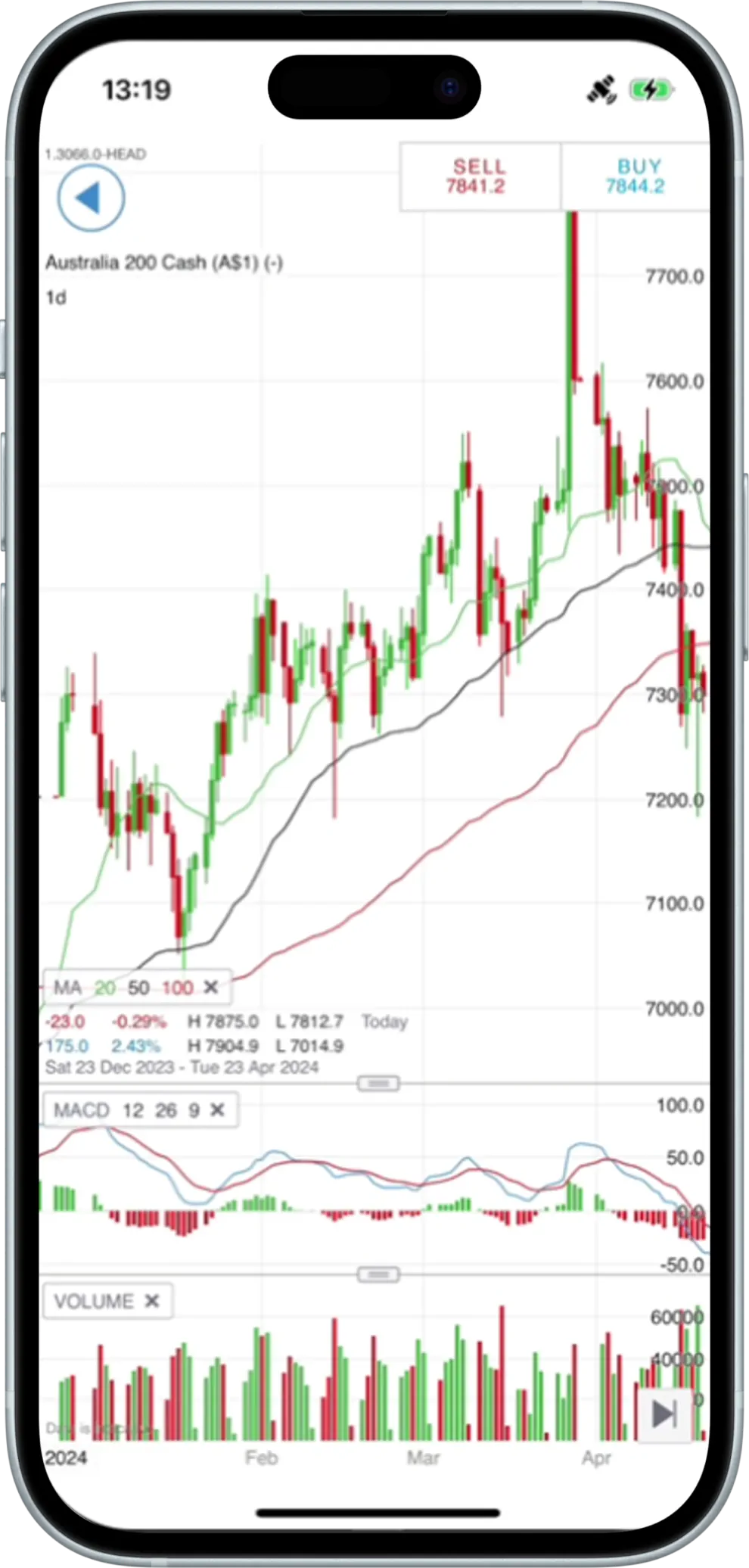
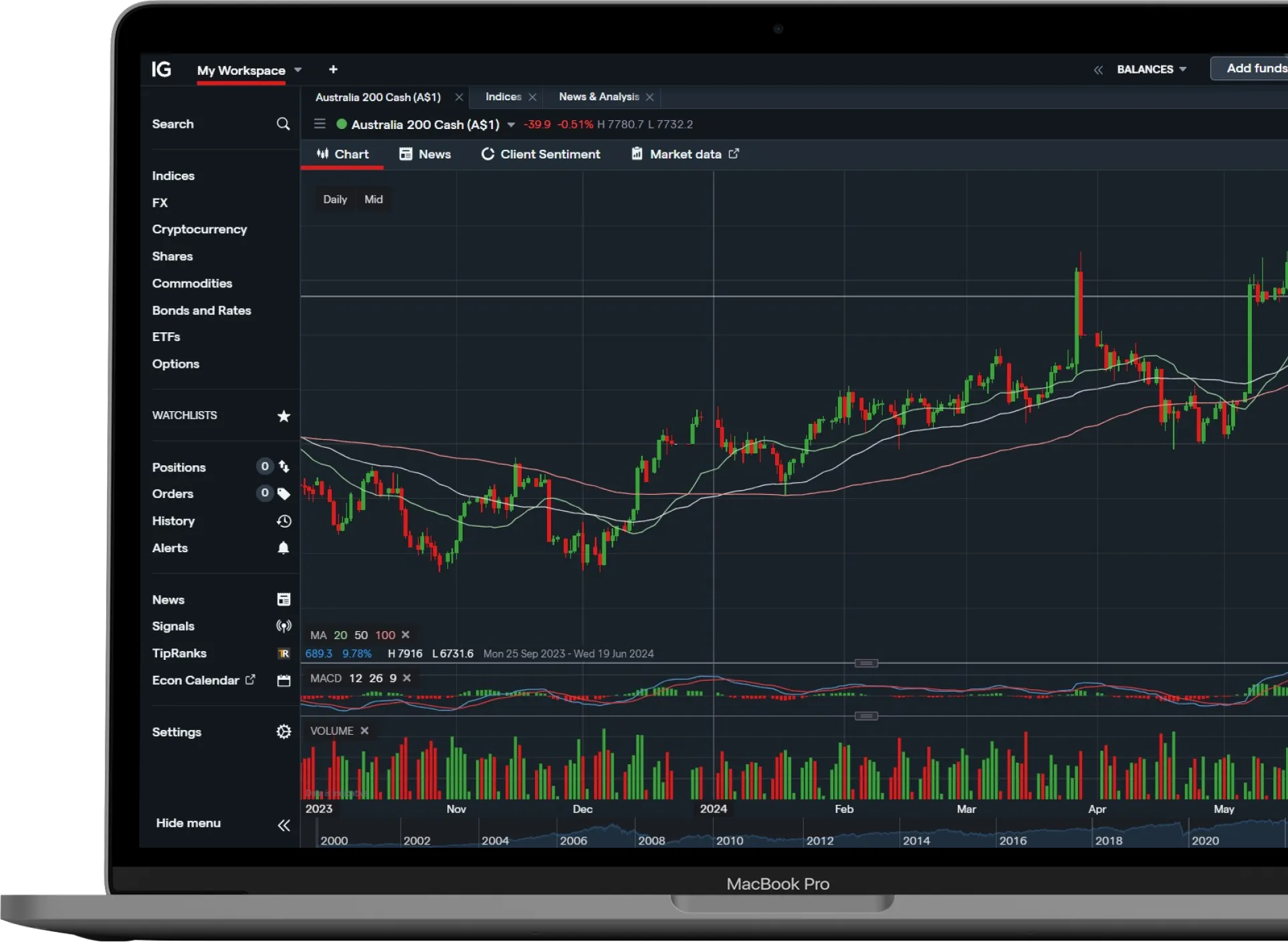

Equip yourself for success
With powerful trading tools
The numbers speak for themselves
0
years’ expertise
0
countries
0
global clients
0
+worldwide markets
Everything you need, in one place
An award-winning platform is just the start
An award-winning platform is just the start

Try our demo account
Test your trading skills and backtest your strategy, without pressure
- A$20,000 virtual funds
- Simulates a live trading environment
- Access exclusive education content
Note that there are key differences between the functionality of Demo and Live accounts to be aware of. Find full details here.
Try demo accountAlways transparent
- Open a trading account, with no hidden costs
- No account management fees, ever
- Get spreads from 1 point on the FTSE 100 and Australia 200, and 0.4 on the US 500 6
CFD trading enables you to take a position with leverage, meaning you only need to put down a deposit – known as margin – to receive increased exposure. The margin required to open a position will vary depending on the market, and on whether you are a retail or IG Pro account.
| Market | Retail margin | Leverage equivalent | Pro Level 1 margin i Professional clients are exempt from product intervention measures such as leverage limits, and are able to trade on lower margins as a result. | Pro Level 2 margin i Professional clients are exempt from product intervention measures such as leverage limits, and are able to trade on lower margins as a result. | Leverage equivalent |
|---|---|---|---|---|---|
| Australia 200 | 5.00% | 1:20 | 1.00% | 0.40% | 1:250 |
| Wall Street | 5.00% | 1:20 | 1.00% | 0.40% | 1:250 |
| Germany 40 | 5.00% | 1:20 | 1.00% | 0.40% | 1:250 |
| US Tech 100 | 5.00% | 1:20 | 1.00% | 0.40% | 1:250 |
| FTSE 100 | 5.00% | 1:20 | 1.00% | 0.40% | 1:250 |
| US 500 | 5.00% | 1:20 | 1.00% | 0.40% | 1:250 |
| Hong Kong HS 50 | 10.00% | 1:10 | 1.50% | 1.20% | 1:83 |
| Japan 225 | 5.00% | 1:20 | 1.00% | 0.40% | 1:250 |
| Weekend Wall Street Cash | 5.00% | 1:20 | 1.00% | 0.40% | 1:250 |
| Weekend UK 100 Cash | 5.00% | 1:20 | 1.00% | 0.40% | 1:250 |
| Weekend Germany 40 Cash | 5.00% | 1:20 | 1.00% | 0.40% | 1:250 |
| Weekend Hong Kong HS50 | 10.00% | 1:10 | 1.50% | 1.20% | 1:83 |
*Maximum leverage that applies unless you have been notified otherwise in writing.
Learn more about our marginsThe spread is the charge you pay us for executing your trade, calculated as the difference between the buy and sell prices of an underlying market. We’re constantly working to keep our spreads among the lowest in the industry. Spreads are subject to change.
| Market | CFD trading min. spread | MT4 |
|---|---|---|
| Wall Street | 2.4 | 2.4 |
| Germany 40 | 1.2 | 1.2 |
| US Tech 100 | 1 | 1 |
| FTSE 100 | 1 | 1 |
| US 500 | 0.4 | 0.4 |
| Hong Kong HS 50 | 5 | 5 |
| Japan 225 | 7 | 7 |
| Weekend UK 100 Cash | 5 | - |
| Weekend Germany 40 Cash | 6 | - |
| Weekend Wall Street Cash | 12 | - |
| Weekend Hong Kong HS50 | 35 | - |
Our foundations
- Established and trusted: FTSE 250 listed 7
- Join the market leaders: 1 50 years’ trusted experience
- Always be informed: direct access to expert analysis and IG’s latest news
- IG Academy: acquire vital knowledge and crucial skills
- Peer support: join and interact with a community of expert traders
Search our markets then start your journey.
FAQs
Indices trading means that you are taking a position on a share index – which is a measure of the performance of several different companies. Indices trading can be a way to get exposure to an entire sector or economy at once, without having to open positions on lots of different shares.
You can profit from index trading by accurately predicting an index’s price movements. For example, if you think the Australia 200 (ASX 200) will rise, you would open a long position. But, if you think it will fall, you would open a short position. Your profit or loss is determined by the extent to which your forecast is correct.
If you decide to trade indices with our products, please note that all leveraged derivatives are complex instruments and come with a high risk of losing money rapidly.
Before trading, you should always consider whether you understand how the instruments work and whether you can afford to take the high risk of losing your money.
To buy index futures means that you are opening a long position on an index because you think the price will increase. If you are correct in your forecast, you will profit, but if you are incorrect, you will incur a loss.
Index futures are a financial derivative. Their price is based on the price in an underlying market, which is influenced by supply, demand and volatility. You can speculate on index futures with CFDs, and they will be traded at the futures price – meaning that you won’t incur overnight funding charges.
You can hedge risk with index futures by taking a position that will turn to profit if one or more of your existing positions starts to lose money. For example, if you held long positions on a selection of US tech shares, you could open a short position on the US Tech 100 to offset any losses you might incur from the shares declining in value.
Alternatively, if you held short positions on a collection of large-cap UK shares, you could open a long position on a FTSE 100 index future to protect yourself against any possible increases in the price of the underlying shares.
You can sell futures before expiry, and many traders will exit their positions before the expiry date arrives. To do so, you can sell your contract outright or purchase an opposing contract which cancels out your current position.
You can trade the ASX 200 with CFDs, which are financial derivatives that mirror the underlying market price of the ASX 200 index. CFDs can be used to go long and speculate on the price of the ASX 200 rising, or you can go short and speculate on the price falling.
They are also an effective way to hedge risk in any of your existing ASX 200 positions, such as if you have directly invested in ASX 200 shares or an ASX 200 ETF.
For example, if you thought that one of your share investments was going to decline in value for a short time, you could open a short CFD position. In a hedge, the profits on your short CFD position would offset a proportion of the losses on your share investment if the market dropped.
Before you trade the ASX 200, you should carry out your own fundamental analysis of the constituent companies’ performance, the government’s economic policy and current economic conditions, and technical analysis of the index’s previous price movements.
The ASX 200’s constituents are the 200 largest companies that are listed on the Australian Securities Exchange. Because the largest companies are always changing, the companies which make up the ASX 200 are constantly reviewed.
You can trade the HS50 via CFDs on cash indices or index futures. When trading cash indices, you deal at the current price of the underlying market and when trading index futures, you choose to trade the HS50 at a specific price on a specific date.
Before trading the Hang Seng 50, do your research and understand how the index works – how it’s calculated and what affects it price. Then, decide whether you want to trade or invest in the index. Try out IG’s demo platform or open a live trading account if you’re ready to take on the live markets.
Companies get onto the HS50 by having a market capitalisation that is among the top 50 on the SEHK. If the share price of a company drops significantly, negatively affecting its market capitalisation, it could drop off the HS50 list. The opposite is true if share prices go up. A new company could make it onto the HS50, causing another company to lose its place.
The VIX measures the implied volatility of the S&P 500 (SPX), based on the price of SPX options. It is calculated and published by the Chicago Board Options Exchange (CBOE). As the S&P 500 is widely regarded as a barometer for US stock market health, the VIX is thought to measure implied volatility across US stock indices.
When the VIX is low, it means there is less market fear, more stability and long-term growth. The VIX typically has a negative correlation with the S&P 500, so when the VIX is low, the S&P 500 is usually experiencing a rise in price.
When the VIX is up, it means that there are significant and rapid price fluctuations on the S&P 500. The VIX typically has a negative correlation with the S&P 500, so in periods of market stress, the VIX increases.
The FTSE 100 is an index of the UK’s largest 100 public companies by market capitalisation. It has become a popular way to gain exposure to the UK stock market and track the performance of the country’s economic health. The market capitalisation of the index has grown significantly since its inception in 1984, as its constituents have experienced success and growth.
With us, there are a number of ways to gain exposure to the FTSE 100. You can:
- Trade the FTSE 100 index on a CFD account directly
- Trade or invest in FTSE 100 ETFs
- Trade or invest in shares of companies included in the FTSE 100
When trading the FTSE 100, you’ll do so using CFDs. Here, you’ll speculate exclusively on the underlying asset’s price movements – in this case, either fluctuations in the index level of the FTSE 100, or movements in the prices of FTSE 100 ETFs or shares.
When investing in the FTSE 100, on the other hand, you’ll do so via our share trading platform. This means that you’ll buy and own actual assets – for example, shares in a FTSE 100-tracking ETF or FTSE 100-constituent company.
Before trading the FTSE 100, make sure you do your research and understand how the index works. Then, decide whether you want to trade or invest.
To get onto the FTSE 100, a company must be listed on the London Stock Exchange (LSE) and it must be one of the top 100 companies by market capitalisation on the exchange. If its market capitalisation drops drastically, a company might lose its listing on the FTSE 100.
The Dow Jones index is comprised of 30 stocks, which are widely considered to be the biggest and best in their respective industries. These include Apple, Microsoft, Nike, Coca-Cola, Boeing, Disney, McDonald’s and Johnson & Johnson, among others.
With us, you can trade and invest in the Dow Jones index in a number of ways. You can trade via CFDs on our Wall Street market, ETFs and, shares. You can also trade the spot (cash) price or futures.
If you’d prefer to invest, you can do so using share trading or ETFs on our share trading platform.
The stocks on the Dow Jones index don’t change often and are hand-selected as titans of their industry. That’s because the caretaker of the Dow Jones index, the S&P Dow Jones Indices company, votes on the stocks to include on the Dow Jones via committee. This means companies cannot apply to join the Dow Jones but are independently chosen by members of the S&P Dow Jones Indices.
The NASDAQ 100 is comprised of the 100 biggest companies (or 102 biggest securities, if you want to get technical) trading on the NASDAQ stock exchange in the United States. These include household names like Google’s Alphabet Inc, Apple, Facebook, Microsoft, Amazon and Tesla.
There are a few ways you can trade or invest in the NASDAQ 100 with us. Firstly, you can open a CFD trading account and trade on the NASDAQ 100 via our exclusive US Tech 100. Alternatively, you can use CFDs to trade on NASDAQ 100-listed stocks or a NASDAQ ETF. You can also trade the NASDAQ via options or futures.
If you’d prefer to invest, you can open a share trading account with us and buy NASDAQ 100 companies’ stocks outright or invest in a NASDAQ-tracking ETF.
Companies come onto the NASDAQ 100 automatically. This is because the NASDAQ 100 is a capitalisation-weighted index. This means that, if a company is listed exclusively on the NASDAQ, it is weighed by size (market cap) and the 100 biggest companies by market cap on the NASDAQ exchange are included in the NASDAQ 100 automatically.
Each year, the NASDAQ 100 index is reranked in this way. So, all a company needs to do to ‘join’ the NASDAQ 100 list is be of the 100 biggest companies listed on the exchange in that year.
Note that they must be non-financial companies, as insurers, banks and other financial firms are instead included on the separate NASDAQ Financial 100 index.


